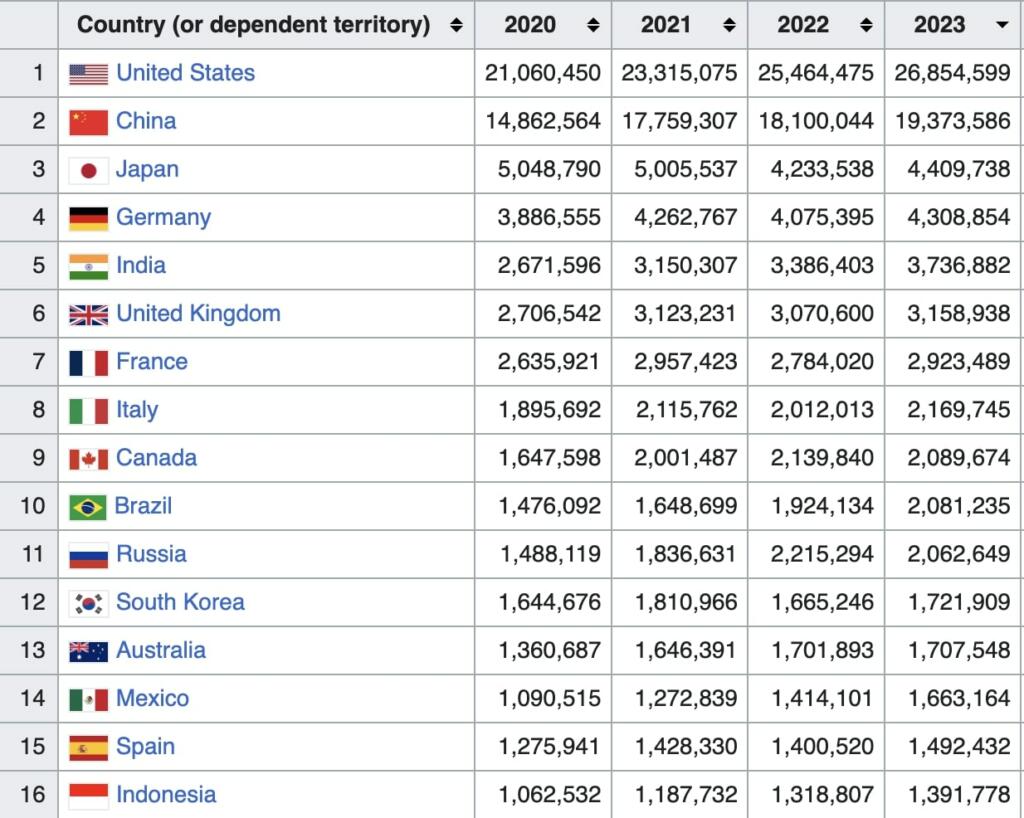California's Economic Rise: Now The World's Fourth Largest Economy

Table of Contents
The Pillars of California's Economic Strength
California's economic dominance rests on several key pillars, each contributing significantly to its overall prosperity. These pillars are interconnected, creating a powerful synergistic effect that fuels growth and innovation.
Technology and Innovation: The Silicon Valley Effect
Silicon Valley's influence on California's economy is undeniable. This region, synonymous with technological advancement, houses some of the world's most valuable companies and attracts top talent from around the globe.
- Key Players: Google, Apple, Facebook (Meta), Tesla, Intel, and countless innovative startups contribute billions to the state's GDP.
- Impact: The tech sector fuels massive job creation, drives technological advancements that reshape global industries, and establishes California as a leader in the global marketplace. This innovation extends beyond Silicon Valley, with thriving tech hubs in San Diego, Los Angeles, and other areas.
- Challenges: Intense competition, both domestically and internationally, is a constant pressure. The high cost of living in California presents a significant challenge in attracting and retaining top talent, leading to some "brain drain" to more affordable locations.
Entertainment and Media: Beyond Hollywood
California's entertainment and media industries extend far beyond Hollywood, encompassing a vast network of creative endeavors.
- Key Sectors: Film production, television, music, video gaming, animation, and digital media contribute significantly to California's economic output.
- Impact: These industries generate substantial revenue, attract tourism, and exert a powerful global cultural influence, shaping trends and perceptions worldwide. The creative industries also support related sectors, like hospitality and advertising.
- Challenges: The rise of streaming services has disrupted traditional models, and competition from other entertainment hubs globally is increasing. The industry is also grappling with the need for greater diversity and inclusivity.
Agriculture: A Surprisingly Robust Sector
Despite its image as a technology and entertainment powerhouse, California maintains a surprisingly robust agricultural sector.
- Key Products: California is a leading producer of fruits, vegetables, nuts, dairy products, and wine grapes, contributing significantly to the nation's and the world's food supply.
- Impact: Agricultural exports generate significant revenue, support related industries like processing and distribution, and contribute to food security both domestically and internationally.
- Challenges: Water scarcity, exacerbated by climate change, poses a major threat. Rising labor costs and competition from other agricultural regions also present significant challenges.
Factors Contributing to California's Economic Growth
Beyond its core industries, several other factors have fueled California's economic expansion.
Highly Skilled Workforce: A Talent Magnet
California boasts a large and highly skilled workforce, a key driver of its economic success.
- Universities and Colleges: Prestigious institutions like Stanford University, UC Berkeley, Caltech, and UCLA produce a steady stream of highly educated graduates, attracting innovative companies and supporting high-tech industries.
- Impact: This talent pool is a major draw for businesses, fostering innovation and ensuring a competitive edge in the global market.
- Challenges: The high cost of living continues to be a barrier, leading to some skilled workers relocating to more affordable states – a concerning "brain drain." Attracting and retaining diverse talent remains a key goal.
Venture Capital and Investment: Fueling Innovation
California's vibrant venture capital ecosystem provides abundant funding for startups and growth companies.
- Silicon Valley's Role: Silicon Valley serves as the global epicenter for venture capital investment, attracting significant funding for innovative ventures.
- Impact: This influx of capital fuels innovation, supports entrepreneurial ventures, and fosters the creation of new industries and technologies.
- Challenges: Competition for funding can be fierce, and the potential for speculative bubbles always exists. Ensuring responsible investment practices is critical for long-term sustainable growth.
Favorable Business Environment (with caveats):
While California's high taxes are often cited as a drawback, the state also offers a compelling business environment.
- Positive Aspects: Access to a large consumer market, a diverse and skilled talent pool, and a generally pro-business attitude (despite regulatory hurdles) contribute to its appeal.
- Challenges: High taxes, complex regulatory hurdles, and the high cost of doing business remain significant challenges that need careful consideration and potential reforms.
Challenges Facing California's Economy
Despite its remarkable success, California's economy faces several significant challenges.
High Cost of Living: A Major Hurdle
The high cost of living, particularly housing, significantly impacts California's economy.
- Impact: High housing costs, transportation expenses, and the overall high cost of living limit affordability, affecting workforce recruitment and retention, and contributing to social inequality.
- Potential Solutions: Increased housing supply through zoning reforms, investment in affordable housing initiatives, and improved public transportation are crucial steps towards mitigating this challenge.
Income Inequality: A Growing Divide
Income inequality is a significant issue in California, with a widening gap between the wealthy and the less fortunate.
- Impact: This inequality contributes to social unrest, reduces economic mobility, and undermines social cohesion.
- Potential Solutions: Progressive taxation policies, robust social safety nets, investments in education and job training, and policies that promote economic inclusion are necessary to address this challenge.
Environmental Concerns: A Looming Threat
Climate change and environmental concerns pose significant risks to California's economy.
- Impact: Climate change threatens agriculture, infrastructure, and public health, requiring significant investment in mitigation and adaptation strategies.
- Potential Solutions: Investment in renewable energy sources, water conservation measures, climate-resilient infrastructure development, and sustainable land management practices are crucial for long-term economic sustainability.
Conclusion
California's remarkable economic rise to become the world's fourth largest economy is a testament to its innovative spirit, highly skilled workforce, and powerful industries. While significant challenges remain, particularly regarding the high cost of living and income inequality, California's economic engine continues to drive global innovation and influence. Understanding the factors contributing to this success, as well as the challenges that lie ahead, is crucial for shaping a sustainable and inclusive economic future. Learn more about California's economic growth and its future prospects by exploring further resources on this dynamic economy. Invest in understanding California's economy – it’s a global force to be reckoned with, and its future will shape the global economic landscape.

Featured Posts
-
 Can Harvard Be Saved A Conservative Professors Perspective
Apr 26, 2025
Can Harvard Be Saved A Conservative Professors Perspective
Apr 26, 2025 -
 A Timeline Of Karen Reads Murder Convictions And Appeals
Apr 26, 2025
A Timeline Of Karen Reads Murder Convictions And Appeals
Apr 26, 2025 -
 Assessing The Long Term Viability Of Chinese Auto Manufacturers
Apr 26, 2025
Assessing The Long Term Viability Of Chinese Auto Manufacturers
Apr 26, 2025 -
 The Ripple Effect A Rural School 2700 Miles From Dc And Trumps Presidency
Apr 26, 2025
The Ripple Effect A Rural School 2700 Miles From Dc And Trumps Presidency
Apr 26, 2025 -
 Gambling On Calamity Exploring The La Wildfire Betting Phenomenon
Apr 26, 2025
Gambling On Calamity Exploring The La Wildfire Betting Phenomenon
Apr 26, 2025
